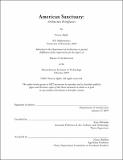| dc.contributor.advisor | Azra Akšamija. | en_US |
| dc.contributor.author | Aljabi, Noora. | en_US |
| dc.contributor.other | Massachusetts Institute of Technology. Department of Architecture. | en_US |
| dc.coverage.spatial | n-us--- | en_US |
| dc.date.accessioned | 2019-07-15T20:34:37Z | |
| dc.date.available | 2019-07-15T20:34:37Z | |
| dc.date.copyright | 2019 | en_US |
| dc.date.issued | 2019 | en_US |
| dc.identifier.uri | https://hdl.handle.net/1721.1/121691 | |
| dc.description | This electronic version was submitted by the student author. The certified thesis is available in the Institute Archives and Special Collections. | en_US |
| dc.description | Thesis: M. Arch., Massachusetts Institute of Technology, Department of Architecture, 2019 | en_US |
| dc.description | Cataloged from student-submitted PDF version of thesis. | en_US |
| dc.description | Includes bibliographical references (pages 129-131). | en_US |
| dc.description.abstract | The United States has a long history of harsh and discriminatory immigration policies, which has often been in tension with those who believe in the nation's promise to take in the "tired, . . . poor, . . . huddled masses." This tension has led to a growing Sanctuary Movement across the country, as people have joined together to protect their undocumented neighbors from the increasingly severe deportation tactics of the Immigration and Customs Enforcement, or ICE. As part of this movement, several states, counties, and cities around the country have declared themselves "sanctuaries" and have limited their cooperation with federal government efforts to enforce immigration law. Although the notion of sanctuary in the U.S. has centered on immigration policies, it should also be considered as an architectural and spatial phenomenon. The spaces in which ICE raids take place, such as the home, the workplace, and the courthouse, have been complicit in allowing for the transgression of rights during immigration arrests. Thus, there is a need for architectural interventions to resist this injustice. Through the exploration of multiple narrative outcomes of raids at the home, the workplace, and the courthouse, this thesis aims to demonstrate the capacity of architecture to change a sequence of events, while also recognizing the unpredictability of design decisions. This approach tests the limits of architectural agency in resisting injustice as part of the Sanctuary Movement--not by providing solutions, but rather by speculating on the many ways that Architecture can participate in producing social change by engaging with other disciplines, such as Law. | en_US |
| dc.description.statementofresponsibility | by Noora Aljabi. | en_US |
| dc.format.extent | 131 pages | en_US |
| dc.language.iso | eng | en_US |
| dc.publisher | Massachusetts Institute of Technology | en_US |
| dc.rights | MIT theses are protected by copyright. They may be viewed, downloaded, or printed from this source but further reproduction or distribution in any format is prohibited without written permission. | en_US |
| dc.rights.uri | http://dspace.mit.edu/handle/1721.1/7582 | en_US |
| dc.subject | Architecture. | en_US |
| dc.title | American sanctuary : architecture & (in)justice | en_US |
| dc.title.alternative | Architecture & (in)justice | en_US |
| dc.title.alternative | Architecture and injustice | en_US |
| dc.type | Thesis | en_US |
| dc.description.degree | M. Arch. | en_US |
| dc.contributor.department | Massachusetts Institute of Technology. Department of Architecture | en_US |
| dc.identifier.oclc | 1102593870 | en_US |
| dc.description.collection | M.Arch. Massachusetts Institute of Technology, Department of Architecture | en_US |
| dspace.imported | 2019-07-15T20:34:35Z | en_US |
| mit.thesis.degree | Master | en_US |
| mit.thesis.department | Arch | en_US |
